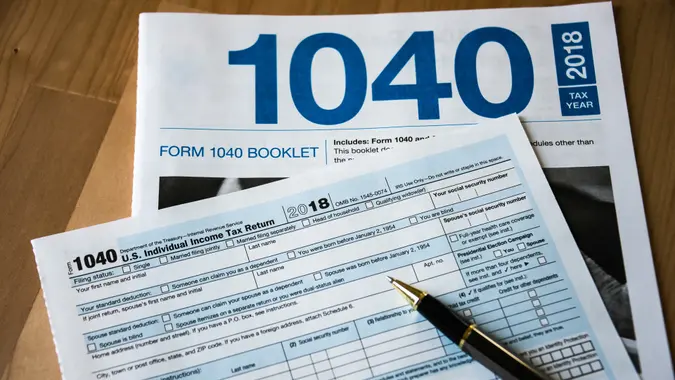Head of Household vs. Single

Commitment to Our Readers
GOBankingRates' editorial team is committed to bringing you unbiased reviews and information. We use data-driven methodologies to evaluate financial products and services - our reviews and ratings are not influenced by advertisers. You can read more about our editorial guidelines and our products and services review methodology.

20 Years
Helping You Live Richer

Reviewed
by Experts

Trusted by
Millions of Readers
Head of household is a filing status for unmarried people who pay for a household that includes a child or other qualifying dependent. It comes with a more favorable tax treatment than filing as a single person.
If you’re eligible, you might be able to lower your tax bill and qualify for more valuable credits by filing as a head of household.
Who Qualifies for Head of Household Filing Status?
Most taxpayers must be unmarried to qualify for the head of household filing status. However, there are exceptions for separated couples who have lived apart from their spouses for at least the last six months of the tax year.
They must also live with a qualifying claimed dependent for more than half the year, including:
- Children
- Parents
- Stepchildren
- Foster children
- Grandchildren
- In-laws
What Is the Difference Between Head of Household and Single?
Single filers are unmarried or legally separated and generally do not support any dependents.
Head of household filers are unmarried or considered unmarried by IRS standards — think common-law marriage — and also support qualifying dependents.
How to Claim a Child Dependent
Follow these steps to claim a child as a dependent.
- Read the IRS rules on dependents to ensure the child you’re claiming qualifies.
- Read the IRS rules on head of household status, specifically, to ensure your relationship and living situation with the child are within regulations.
- Once verified, gather the dependent’s full name, Social Security number and relationship.
- Use Form 1040 to claim the dependent.
- File Schedule 8812 with your Form 1040 to claim the Child Tax Credit, if applicable.
How to Claim an Adult Dependent
Follow these steps to claim an adult as a dependent.
- Read the IRS document “Who Is a Qualifying Person Qualifying You To File as Head of Household?” to learn which adults meet the eligibility requirements for the head of household status.
- Once verified, gather the dependent’s personal information, including their full name, Social Security number and your relationship.
- Use Form 1040 to claim the dependent.
- Use the IRS tool “Does my child dependent qualify for the child tax credit or the credit for other dependents?” to learn if you’re eligible for credits.
What Are the Tax Advantages of Filing as Head of Household?
The following are the IRS’s 2025 tax brackets, which show that heads of households enjoy substantially favorable tax treatment over single filers — until they earn six figures, when the benefits end.
| Federal Tax Rate | Single Filers | Heads of Households |
|---|---|---|
| 10% | $0 to $11,925 | $0 to $17,000 |
| 12% | $11,925 to $48,475 | $17,000 to $64,850 |
| 22% | $48,475 to $103,350 | $64,850 to $103,350 |
| 24% | $103,350 to $197,300 | $103,350 to $197,300 |
| 32% | $197,300 to $250,525 | $197,300 to $250,500 |
| 35% | $250,525 to $626,350 | $250,500 to $626,350 |
| 37% | $626,350 or more | $626,350 or more |
More favorable tax brackets are not the only benefit to filing as a head of household instead of as a single filer.
- For tax year 2025, the standard deduction is $22,500 for heads of households compared to $15,000 for single filers.
- Filing as a head of household can expand your eligibility for credits like the Child Tax Credit and Earned Income Tax Credit (EITC).
- Head of household status can result in a larger EITC for those who qualify.
The Bottom Line
Unmarried people or common-law couples might qualify for head of household filing status if they claim qualifying dependents on their returns. The rules are rigid, but the IRS outlines them clearly, and those who are eligible can qualify for valuable credits and favorable tax brackets that the same taxpayer might not receive if filing as single.
FAQ
Here are some frequently asked questions about filing for taxes.- How can you lower your tax bracket to pay a lower federal income tax rate?
- You can take tax deductions to lower your taxable income percentage, and you can take tax credits to reduce the amount of tax you owe.
- Can you still file as head of household if you are married?
- In most cases, you cannot file as head of household while married. According to the IRS, head of household filing status is for taxpayers who are unmarried and support others living in the household. However, the IRS allows you to file as head of household if you are preparing to divorce your spouse and you lived together for less than half of the year.
- If you are divorced, can your ex-spouse and you both claim head of household and claim your children as dependents?
- Only one parent can claim the children as dependents -- the parent who provides more than half of the children's living expenses during the tax filing year.
Kathy Evans contributed to the reporting for this article.
Our in-house research team and on-site financial experts work together to create content that’s accurate, impartial, and up to date. We fact-check every single statistic, quote and fact using trusted primary resources to make sure the information we provide is correct. You can learn more about GOBankingRates’ processes and standards in our editorial policy.
- IRS. "Filing Status."
- IRS. "IRS provides tax inflation adjustments for tax year 2022."
- IRS. "Publication 504, Divorced or Separated Individuals."
- IRS. "Overview of the Rules for Claiming a Dependent."
- IRS. "Who Is a Qualifying Person Qualifying You To File as Head of Household?1"
- IRS. "Administrative, Procedural, and Miscellaneous"
- IRS. "Does my child/dependent qualify for the child tax credit or the credit for other dependents?"
- IRS. "Publication 501 (2024), Dependents, Standard Deduction, and Filing Information"
 Written by
Written by  Edited by
Edited by 

























